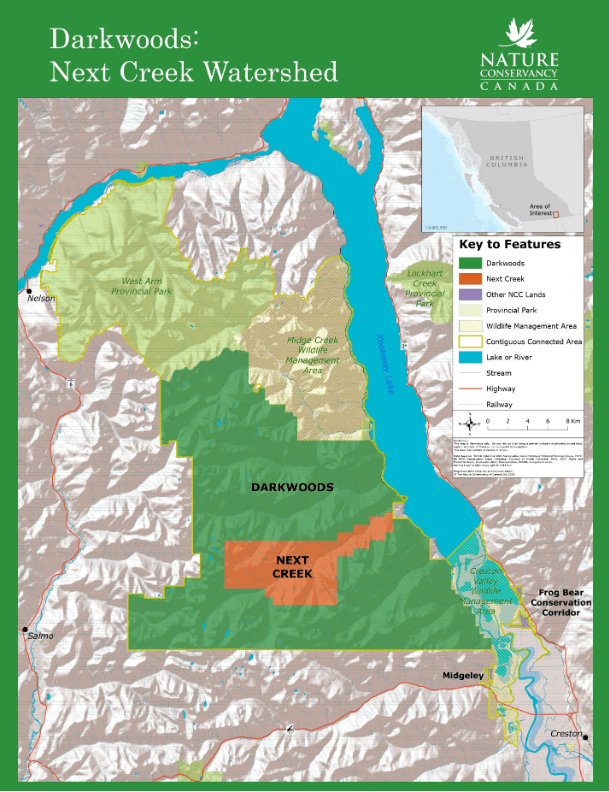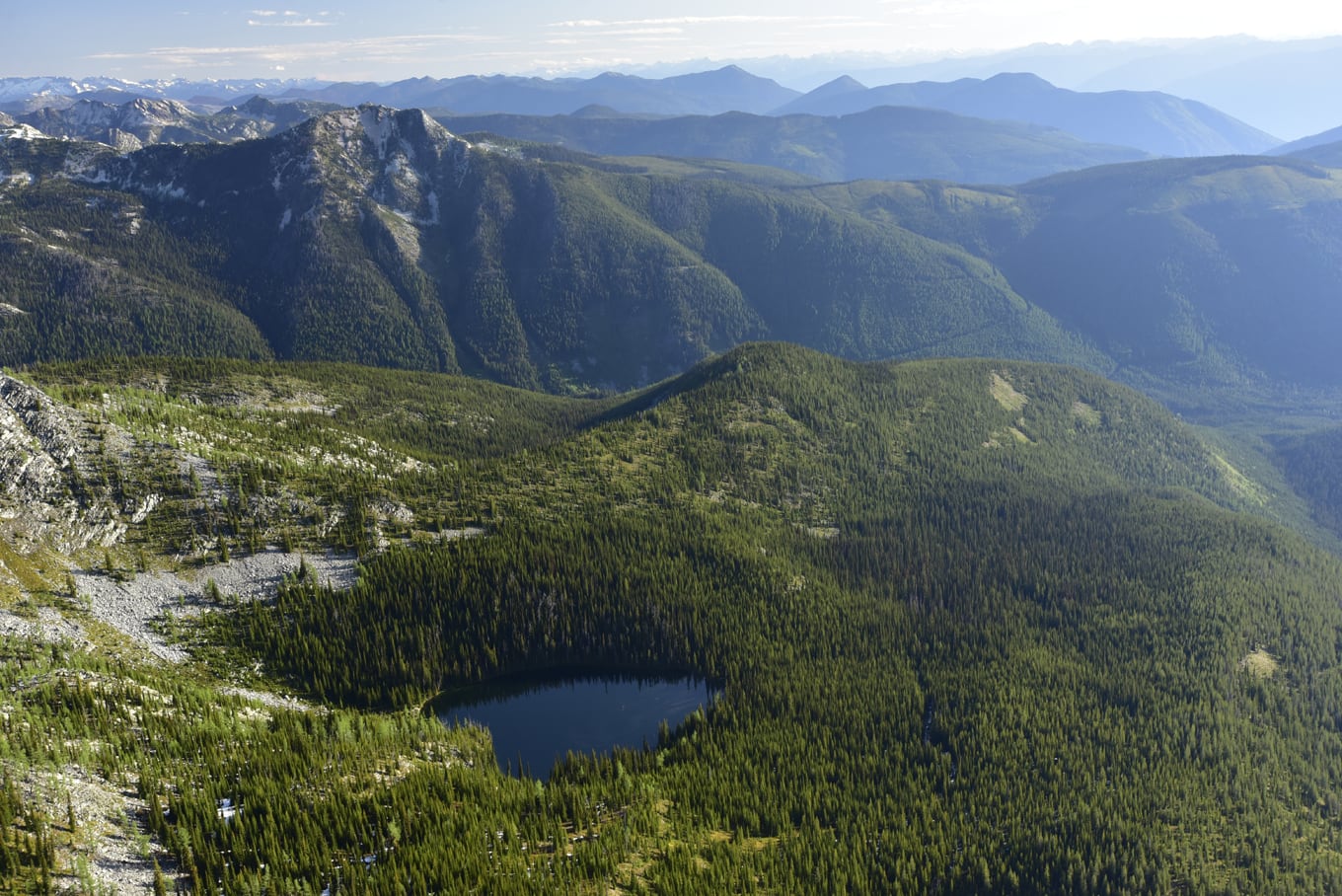Largest private land conservation project in Canada just got bigger
The largest private land conservation project in Canada just got bigger after the Nature Conservancy of Canada (NCC) announced Friday that it has acquired 7,900 hectares (19,500 acres) of rare inland temperate rainforest in the South Selkirk Mountains.
The new conservation lands, situated in the heart of its Darkwoods Conservation Area, between Nelson and Creston, encompass most of the Next Creek watershed, which is now fully protected within Darkwoods. This brings the area to 155,000 acres protected.
The NCC said the acquisition effectively completes the Darkwoods Conservation Area by filling the “hole” that has been in the centre of the conservation area since it was first established by NCC in 2008. (See map and video below.)
Left unprotected, the Next Creek property threatened the integrity of a vast network of conservation lands that spans over 1,100 square kilometres. The property will become part of Darkwoods, expanding the conservation area by 14 per cent.
“Conserving the Next Creek watershed and expanding the Darkwoods Conservation Area presented an incredible opportunity to fulfill a conservation vision that started over a decade ago,” said Nancy Newhouse, BC regional vice-president, Nature Conservancy of Canada.
“We are so grateful for all of the people and organizations who believed in this vision of creating an internationally significant conservation impact.”
NCC raised close to $20 million to acquire the Next Creek watershed lands and to provide for the long-term management of the Darkwoods Conservation Area. Foundational investments were made by the Government of Canada, through the Natural Areas Conservation Program, and the Province of British Columbia. Other significant funding came from Columbia Basin Trust, the Fish & Wildlife Compensation Program, The Sitka Foundation, the Regional District of Central Kootenay, FortisBC and the McDanel Land Foundation. Generous donations were made by many individuals, notably: Carla Reed, Andrew Beckerman, Michael and Kathy Gallagher, Eric Grace, MGSP Yacht, Peter Roberts and Lynda Griffiths.
“I would like to congratulate the Nature Conservancy of Canada for their dedication to expand and manage the Darkwoods Conservation Area,” said Catherine McKenna, Minister of Environment and Climate Change Canada.
“With efforts made by partners like the Nature Conservancy of Canada to preserve our natural heritage, our government is making progress towards doubling the amount of protected nature across Canada’s lands and oceans.
“Taking the initiative now to conserve the Next Creek property will ensure our kids and grandkids can connect to nature and experience its wonder.”
George Heyman, BC Minister of Environment and Climate Change Strategy, concurs.
“Our government is proud to work with the Nature Conservancy of Canada, the federal government and others, to further protect the significant ecological values of the Next Creek watershed,” Heyman explained.
“This area provides vital habitat for wildlife, including threatened species. We are committed to preserving B.C.’s natural legacy as Canada’s most biologically diverse province with the highest percentage of protected areas.”
The Darkwoods Conservation Area and Next Creek are located along Kootenay Lake, between Nelson and Creston. The threat of intensified or unsustainable industrial or recreational activity made the acquisition of the Next Creek property NCC’s highest conservation priority in BC.
Darkwoods provides essential habitat for close to 40 confirmed species at risk, including Species At Risk Act (SARA)-listed grizzly bear (special concern), wolverine (special concern), peregrine falcon (special concern), mountain caribou (threatened) and whitebark pine (endangered).
The forest here is a largely intact example of rare inland temperate rainforest. Sometimes called a “snow forest” because it receives most of its moisture from snow, this forest type occurs almost nowhere else on the planet.
“The Nature Conservancy of Canada’s efforts to purchase and then manage lands for conservation have been, and remain, an integral component of re-establishing connectivity in grizzly bear habitat,” said Dr. Michael Proctor, PhD, Trans-border Grizzly Bear Project.
“This is leading to the successful increase in their conservation status in parts of southeastern BC, including the recovery of a threatened population [of bears]. The cooperation between NCC and grizzly bear research scientists has allowed the use of accurate conservation science to be applied where it will do the most benefit.”
Fast Facts:
- Conserving wildlife corridors in the Canadian Rockies is essential to the long-term viability of wide-ranging mammals, such as grizzly bear, black bear, elk, wolverine, caribou and mountain goat.
- Expanding Darkwoods by acquiring the Next Creek property is an opportunity to undertake a substantial restoration plan for the property’s previously logged portions.
- With the addition of Next Creek, the network of conservation lands in the South Selkirk Mountains now spans more than 1,100 square kilometres.
- This network is anchored by NCC’s Darkwoods Conservation Area, which was established in 2008. Darkwoods made history as the single largest private acquisition for conservation in Canadian history.
- The unique forests found here, sometimes known as snow forests because they receive most of their moisture from the snowpack, harbour the highest tree diversity in BC.
- Darkwoods and Next Creek feed 17 watersheds and more than 120 alpine lakes. The freshwater systems are important for the overall health of fisheries in Kootenay Lake.
- Darkwoods and Next Creek are in the traditional territory of the Ktunaxa, the Syilx and the Sinixt peoples.
- Today’s announcement is the culmination of years of work and relates to the November 2018 announcement.
About Nature Conservancy of Canada
The Nature Conservancy of Canada is the nation's leading not-for-profit, private land conservation organization, working to protect our most important natural areas and the species they sustain. Since 1962, NCC and its partners have helped to protect more than 1.1 million hectares (2.8 million acres), coast to coast, with more than one quarter of that area in British Columbia. To learn more, visit natureconservancy.ca.


























